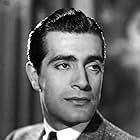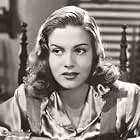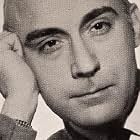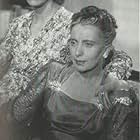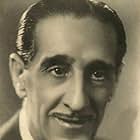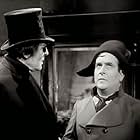In 19th-century Madrid a young man plays roulette. A mysterious character helps him by pointing with his walking stick the next number on which the ball will fall; the protagonist is the onl... Read allIn 19th-century Madrid a young man plays roulette. A mysterious character helps him by pointing with his walking stick the next number on which the ball will fall; the protagonist is the only one able to see him. The mysterious man turns out to be the ghost of an archaeologist an... Read allIn 19th-century Madrid a young man plays roulette. A mysterious character helps him by pointing with his walking stick the next number on which the ball will fall; the protagonist is the only one able to see him. The mysterious man turns out to be the ghost of an archaeologist and asks the young man to defend his niece from a gang of hunchbacks.
- Inés
- (as Isabelita de Pomés)
Featured reviews
It is a genuine oddity: although it was filmed in 1944, its aesthetic and atmosphere evoke a much earlier era of filmmaking. The plot - strange, labyrinthine, almost arbitrary - possesses a dreamlike quality reminiscent of silent cinema. The direction, clearly influenced by the visual language of the 1920s, favors expressive compositions and a mise-en-scène that prioritizes symbolism over linear narrative.
The performances, deliberately theatrical, heighten the sense of artifice and unreality. The characters feel less like real people and more like archetypal figures trapped in a gothic dream. Meanwhile, the production design is remarkable: twisted sets, elongated shadows, and impossible architecture that would not feel out of place in a film like Nosferatu or in the early Universal horror classics such as The Phantom of the Opera or Frankenstein.
Altogether, The Tower of the Seven Hunchbacks is a cinematic experiment both ahead of its time and deeply rooted in the styles of the past. Its blend of mystery, horror, folklore, and expressionist flair makes it a unique gem - as fascinating as it is bewildering - that deserves to be rediscovered by new generations of cinephiles.
The Tower of the Seven Hunchbacks is something of an oddity: although made in 1944, it looks and feels like something from much earlier, its bizarre, seemingly-random plot possessing the dreamlike quality of a silent movie; the direction and acting also have that silent era quality, with the cast giving somewhat exaggerated performances, while the production design wouldn't look out of place in a German expressionist picture of the '20s or an early Universal horror (the spiral stairs leading down to the underground city being the most impressive shot). The film starts off with a jaunty musical number in a nightclub, adds humour with a scene in which de Mantua helps Basilio to win at roulette, gets really daft with the introduction of Napolean's ghost, and turns into a mystery with Inés abduction. The finalé adds suspense to the mix, as Basilio navigates a network of tunnels, locates the hidden city that is home to the hunchbacks, and attempts to escape with Inés.
It's all a bit too scattershot in tone and narrative for me to call it a great film (I'm still unsure as to why the villains are all hunch-backed), but it's also this randomness that makes it a fun watch.
From what I could gather (the Spanish language is partly similar to the Italian in which I'm fluent, but the worn soundtrack present here didn't make it any easier for me!) is fairly rich in twists with a one-eyed ghost (who, Cocteau-like, uses a mirror as a portal from the netherworld) bidding our hero to seek a secret society of hunchbacks involved in the trafficking of archaeological artifacts (but, from reading what few reviews I could find about the film, the latter's also asked to protect the old man's daughter and help her expose his own murderer). While I'm at it, let me just catalogue what other plot/visual elements seem to have escaped me (or else have already receded into my subconscious given that I was watching it somewhat half-heartedly): the city of Hunchbacks was apparently built by victimized Jews during the Spanish Inquisition; there's talk of "thrilling horrors", "cobwebbed mummies" and "hypnotism", plus the fact that the villain (who, admittedly, is quite effective) is allowed to get away with it.
Even so, these reviews are equally contradictory: one calls it "anything but conventional" whereas another states "while the movie has a wonderfully expressionist look and the story is certainly inventive, the plot unfolds in a very conventional way, and while entertaining, it isn't exactly the masterpiece that could have been or that its very artistic look may indicate" for what it's worth, I tend to favor this latter view! Incidentally, while it would seem to evoke the feel of the contemporaneous Universal horror films, THE TOWER OF THE SEVEN HUNCHBACKS is really an obvious precursor to the loopier Mexican variety of genre outings which came into full swing during the subsequent decade. Like these other film buffs, however, I regretted the picture's comic relief (apparently, the source novel is more somber) at one point, for no apparent reason, even Napoleon's ghost puts in an appearance! and even more so the musical sequences.
What eventually made the film worthwhile, then, were the atmospheric sets (even if, at this juncture, I wouldn't quite use the epithet "must be seen to be believed" to describe them!) and monochrome lighting. Needless to say, I'm grateful for the opportunity to sample this 'lost classic' but I'd love to revisit it in an improved edition though, alas, I'm not holding my breath!
A mysterious and suspenseful fantasy with intrigue , brief hilarious touches and short in terror . Entertaining and enjoyable criminal movie with fantastic elements containing thrills , suspense , twists and turns . ¨La Torre de Los Siete Jorobados¨(1944) based on a novel by Emilio Carrere , belongs to Edgar Neville trilogy about criiminal intrigues set in an old Madrid , along with ¨Martes De Carnaval¨(1945) and ¨El crimen de la calle Bordadores¨(1946) , all of them written by himself . This intriguing film reflects the traditional Madrid of the late nineteenth century , without missing the typical popular theatrical scenes , Cabaret , Musical Revista and the traditional dances, with specific references to the chotis . Here stands out the impressive settings of the famous Tower and the underground as well as the atmospheric photography in black and and white by Henri Barreyre and Andrés Pérez Cubero , but as cinematography as sound , being really necessary a perfect remastering because the film copy is worn-out . Main and support cast are acceptable , playing some usual actors of the 40s , such as : Antonio Casal , Félix de Pomés, Isabel de Pomes , Guillermo Marin , Antonio Riquelme , Julia Lajos , José Franco as Napoleon , among others . Filming and locations took place in Madrid and Ciudad Lineal studios . As Edgar Neville shot in various Madrid streets : Puerta del Sol, Plaza de la Cebada , and Castizos quarters , among them .
The motion picture was competently written and directed by Edgar Neville . It won some prizes such as Cinema Writers Circle Awards , and Prize of the National Syndicate of Spectacle . Director Edgar Neville , Count of Berlanga de Duero , considered to be one of the best filmmakers in the Francoist time . He was a notorious playwright , screenwriter and director , Edgar opted for a humor not politically compromised , which he cultivated in all genres : theatrical stage , poetry, novels, cinema, painting and others . From their privileged positions he criticized without harshness the customs of the bourgeoisie at that time , in which Neville belonged himself as well as the kitsch and the absurd habits . Together with Tono, Antonio Mingote and Mihura, he wrote for the humor magazine La Codorniz , successor to the weekly La Ametralladora, which Mihura published in San Sebastián. Neville stood out above all as a good filmmaker . ¨La vida en un hilo¨ or ¨Life in a thread¨ was a great success with the public and critic . It was first conceived as a film and later it was turned into a musical comedy by his son Santiago . It is a smiling reflection on the mechanisms of chance, as well as a plot against the bourgeoisie , being understood as a disease of the soul , against cornyness and against narrow-mindedness disguised as common sense . The play ¨El baile¨, which ran for seven years on stage , it was also a great hit . It is about a loving trio that triumphs over time and generations . Adapted to the cinema, it was distinguished by its agile and brilliant dialogues , in which tenderness and nonsense alternate here and there . Edgar directed a number of films , some of them written along with his sweetheart actress Conchita Montes , standing out the following movies : La torre de los siete jorobados 1944 , La vida en un hilo 1945 , El crimen de la calle de Bordadores 1946 ,El traje de luces 1946 , Nada 1947 , El marqués de Salamanca 1948 , El último caballo 1950 , La ironía del dinero 1955 , El baile 1957 , Mi calle 1959 . He also made documentary , such as : La Ciudad Universitaria, Juventudes de España , Duende y Misterio del Flamenco, Cante Jondo, among others .
Set in 19th century Madrid, a young man named Basilio (Antonio Casal) decides to play roulette, hoping to make some money to go on a date with the girl he likes. Suddenly, a mysterious character appears (Félix De Pomés) out of nowhere, and tells Basilio exactly where the ball is going to fall. Winning a small fortune thanks to the stranger, Basilio decides to thank him for the help, only to discover that the mysterious man, named Don Robinson De Mantua, is the ghost of an archaeologist who supposedly committed suicided years ago. In return for the help at the roulette, Don Robinson asks Basilio to protect his daughter Inés (Isabel De Pomés) and help her solve his crime, as Don Robinson was actually murdered. And so Basilio gets involved in a mystery that will take him to discover the entrance to the Tower of the Seven Hunchbacks.
As written above, "La Torre De Los Siete Jorobados" is based on Emilio Carrere's novel of the same name (which was partially written by Jesús De Aragón), however, there are many differences between the novel and the film, specially in the tone that scriptwriters Edgar Neville and José Santugini give to the story. While the novel has a somber dark humor, Neville's film ops for a lighthearted style, more in tone with American horror and adventure movies (that definitely were a big influence on Neville) than with its literary source. This is not really a bad thing, as the movie keeps the thrilling mix of mystery, humor and suspense of the novel, and I'd go as far as to say that Neville's decision of making a fun movie over a meaningful one actually benefits the film, as while certainly an imitation of Hollywood's typical style, it's anything but conventional.
Where the movie excels is in its execution, as Neville gives good use to the excellent work of cinematography done by Henri Barreyre and Andrés Pérez Cubero, giving the film a haunting beauty. The most striking feature of the film is definitely its wonderful set design, with the recreation of the Tower of the Seven Hunchbacks having a beautiful expressionist look that feels like taken out from a 1920s German film. The contrast between the surreal expressionism of the Tower with the Gothic atmosphere of Madrid's streets (in scenes shot on location) give the movie an effective nightmarish look, which definitely bring back memories from the American horror films from the 30s (specially the ones by Universal Studios). However, what makes this mix of influences work is Neville's own brand of humor, which gives the film a distinctive personality of its own.
The cast is for the most part effective, with Antonio Casal leading the cast and making a good job at handling the comedic side of his character (his Braulio is goodhearted, but cowardly and specially naive). As his romantic interest, Inés, actress Isabel De Pomés is good, although nothing really special. Still, this could be blamed to the fact that her character isn't very well developed and it's a stereotypical damsel in distress. On the other hand, Guillermo Marín is extraordinary as the mysterious Doctor Sabatino, delivering a powerful performance that definitely ranks among the best in Spain's horror filmography. Marín captures perfectly the mix of charming amiability and perverse wickedness that makes Sabatino such an interesting character and he is easily the best in the cast. Finally, Félix De Pomés is quite funny as Don Robinson's ghost, despite his limited screen time.
Now, while "La Torre De Los Siete Jorobados" is certainly an excellent and entertaining film, it sadly is far from being perfect, mainly because in his attempt for imitating the commercially successful American films, director Neville also brings those films' flaws, specifically, their reliance on clichés. While the movie has a wonderfully expressionist look and the story is certainly inventive, the plot unfolds in a very conventional way, and while entertaining, it isn't exactly the masterpiece that could had been or that its very artistic look may indicate. This dependence on common clichés and some cheap jokes do make a bit simplistic and predictable what otherwise could had been a quite haunting tale of horror. Fortunately, the damage is not really big, and "La Torre De Los Siete Jorobados" can still be enjoyed without problem.
Of course, this last criticism is probably just nitpicking, as in the end, "La Torre De Los Siete Jorobados" fulfills its purpose without great difficulty: it provides good entertaining as Basilio uncovers the thrilling horrors of the Tower of the Seven Hunchbacks. While it would take several years after this film's release for horror to resurrect completely, "La Torre De Los Siete Jorobados" did open the doors for the fantastic in Spain's filmography. For this and several other reasons (like its expressionist look, which must be seen to be believed), this little known gem is more than a mere curiosity, it is truly Spain's first horror classic.
8/10
Storyline
Did you know
- ConnectionsFeatured in Edgar Neville: Emparedado entre comillas (2000)
Details
- Release date
- Country of origin
- Language
- Also known as
- Tower of the Seven Hunchbacks
- Filming locations
- Production companies
- See more company credits at IMDbPro
- Runtime1 hour 25 minutes
- Color
- Sound mix
- Aspect ratio
- 1.37 : 1
Contribute to this page









